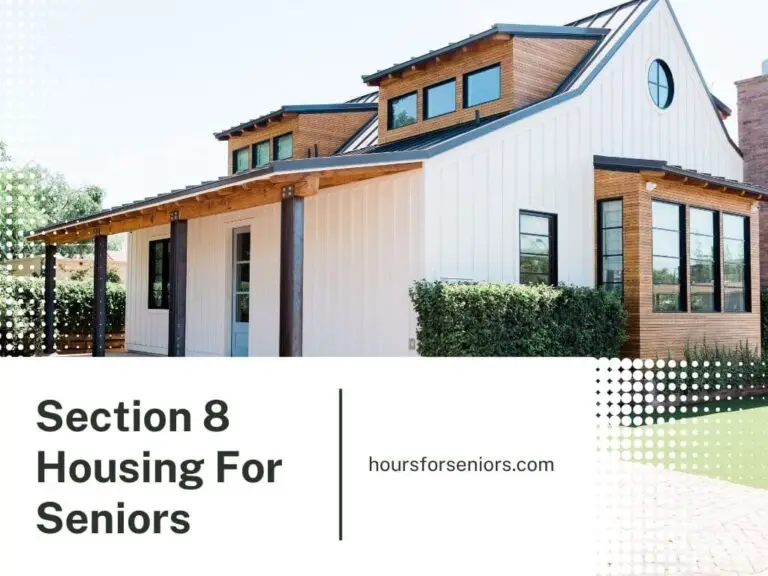How to Apply for Section 8 for Seniors
In the United States, the federal government has long recognized the importance of providing affordable housing options for low-income seniors, individuals and families. Since the passage of the U.S. Housing Act of 1937, various programs have been established to assist those in need, and among them, the Section 8 program has emerged as a significant resource.
For seniors who find themselves facing financial challenges in securing suitable housing, Section 8 can offer a lifeline of support.
Administered by the U.S. Department of Housing and Urban Development (HUD), the Section 8 program aims to alleviate the burden of rental costs by providing housing subsidies for eligible low-income seniors, individuals and families.
Through Section 8, seniors can access affordable housing options that fit their needs and income levels, allowing them to maintain a comfortable living situation during their golden years.
The steps to apply for Section 8 senior housing assistance are listed below:
- Determine Section 8 Eligibility for Senior Housing
- Pre-Application
- Fill Out the Section 8 Application
- Submit the Section 8 Application and Required Documents
- Wait for your Section 8 Application Review
The acceptance of your application may be impacted by certain factors, like the demand in your area and the availability of funds.
Demand often exceeds supply so there may be a waiting list, even if you meet all the criteria. It’s also possible that you may end up on a waiting list until funds become available.

Introduction to the Section 8 Program
The Section 8 program encompasses various forms of housing assistance, including public housing, tenant-based assistance, and project-based housing. Public housing involves local housing agencies receiving HUD funding to develop and manage housing units designated for eligible households.
Tenant-based assistance, the most common form of Section 8, enables participants to seek housing in the private market while receiving rental subsidies.
Project-based housing, on the other hand, entails privately owned rental properties that receive subsidies through contracts with HUD.
While the Section 8 program provides vital support to low-income seniors, navigating the application process can seem daunting for those unfamiliar with its intricacies. This article aims to serve as a comprehensive guide on how to apply for Section 8 specifically tailored for seniors.
By simplifying the application process and providing step-by-step instructions, we hope to empower elderly individuals to access the housing assistance they deserve.
In the following sections, we will delve into the eligibility criteria for Section 8, the application process itself, and important considerations for seniors during their application journey.
We will also address frequently asked questions and provide valuable resources to ensure a smooth and successful Section 8 application experience.
While this article focuses on Section 8 for seniors, other housing subsidy programs exist, such as those offered by the U.S. Department of Agriculture’s Rural Housing Service, Indian Housing, HOME, and Community Development Block Grants (CDBG).
However, our primary focus will be on the Section 8 program and the specific steps seniors need to take to access its benefits.
By understanding the ins and outs of applying for Section 8, seniors can take control of their housing situation and embark on a path toward affordable and comfortable living arrangements.
Let’s explore the process together and unlock the potential of Section 8 assistance for seniors in need.
How to Apply for Senior Housing Assistance Under Section 8
The steps to apply for Section 8 senior housing assistance are listed below:
- Determining Eligibility for Senior Housing under Section 8
- Pre-Application
- Fill Out the Section 8 Application
- Submit the Section 8 Application and Required Documents
- Wait for your Section 8 Application Review
1. Determining Eligibility for Senior Housing under Section 8
When it comes to senior housing under Section 8, meeting specific criteria is essential to determine eligibility.
Below, we have listed the key requirements for Section 8 senior housing, ensuring a comprehensive understanding of the eligibility process:
Income Qualifications
To understand the income qualifications for Section 8 and the amount expected to be paid for rent, it is important to consider the different income classifications.
Households can be categorized as
- low income,
- very low income, or
- extremely low income.
Low-income households typically earn up to 80% of the area median income. Very low-income households can earn up to 50% of the area’s median income, while extremely low-income households may only earn up to 30% of the median income in their area.
Income limits may vary between states and even among different housing authorities. To determine the specific income qualifications and limits applicable to your area, it is advisable to contact your local Public Housing Authority (PHA).
PHAs prioritize applicants with extremely low incomes, followed by those with very low incomes and low-income families.
Family Status
The definition of “family” as defined by HUD encompasses various characteristics that determine whether a household qualifies for Section 8 assistance. The criteria used for defining “family” are listed below in order of priority:
- At least one household member over age 62: HUD recognizes the unique needs of elderly individuals and gives priority to households with at least one member who is 62 years or older.
- At least one household member with a documented disability: HUD also emphasizes the importance of assisting individuals with disabilities. If your household includes a member with a documented disability, you may be eligible for Section 8 assistance.
- A household of multiple members, with or without children: Section 8 assistance is available to households consisting of multiple members, whether or not they have children.
- A single person living alone who meets none of the above criteria: HUD acknowledges that single individuals living alone may also face financial hardships and the need for affordable housing.
While HUD establishes these general guidelines, local public housing authorities (PHAs) have the authority to supplement these qualifications based on the specific needs and conditions of their respective areas.
Disabilities
The presence of disabilities can have an impact on the application process for Section 8 housing assistance. In some cases, Public Housing Agencies (PHAs) may prioritize households that can provide documentation of disability within their members. This prioritization is aimed at addressing the unique housing needs of individuals with disabilities.
To demonstrate eligibility based on disability, applicants must provide appropriate medical evidence and documentation that verifies the disability. Proof of any Social Security disability compensation received can also be presented to support the disability claim.
These documents play a crucial role in establishing the eligibility of the household and determining the level of assistance they may receive.
Citizenship
To demonstrate eligibility for Section 8 assistance, applicants must be U.S. citizens or provide documentation of an eligible immigration status. When submitting the application, it is common to be asked to provide specific documents such as a U.S. passport, a Social Security card, or a Green Card.
In addition to proof of citizenship or eligible immigration status, applicants may be required to sign a declaration confirming that all members of their household are American citizens.
It may also be necessary to submit a copy of the birth certificate for any children residing in the household.
It’s important to note that if not all members of the household can provide proof of citizenship or eligible immigration status, the household may still be eligible for assistance as a “mixed family.”
However, the amount of assistance provided to mixed families will typically be lower than that provided to households in which all members are citizens or can demonstrate approved immigration status.
Criminal Record
The Housing Choice Voucher (HCV) program maintains strict eligibility criteria related to criminal activity and substance abuse.
Under the guidelines set by the U.S. Department of Housing and Urban Development (HUD), the HCV program imposes restrictions on individuals with criminal records, particularly if any household member has been involved in criminal activities within the past five years.
Participation in the Section 8 housing choice program is prohibited for registered sex offenders and individuals convicted of manufacturing methamphetamines in public housing.
Federal guidelines direct Public Housing Agencies (PHAs) to deny applications from individuals who are currently engaging in illegal drug use or substance abuse that may pose a threat to the household or neighboring residents.
Eviction History
The Section 8 program requires the Public Housing Agency (PHA) to conduct thorough assessments of prospective tenants to ensure their compliance with these guidelines. As part of this process, the PHA will engage in discussions with your previous landlords to gather information about your rental history and how you fulfilled your obligations.
During these conversations, the PHA will inquire about various aspects, including your rental payment history, how you maintained your previous rental housing, and any other relevant details.
Their goal is to gain insight into your previous tenancy behavior and assess your suitability for the Section 8 rental assistance program.
One crucial factor that the PHA examines is whether you or any member of your household has been evicted from a rental property within the past three years. Instances of eviction, especially for drug-related crimes, can significantly impact your eligibility for the Section 8 program. If the PHA discovers such an eviction, it will typically result in the denial of your application for rental assistance through Section 8.
Living Within The PHA’s Jurisdiction
To qualify for a Section 8 housing voucher within a specific area, many Public Housing Authorities (PHAs) require applicants to live within the jurisdiction of that PHA. If this is the case for your PHA, you will likely need to provide documentation that verifies your current residency. Acceptable forms of documentation may include a utility bill or official mail sent to your current address.
By understanding these key eligibility factors and ensuring compliance, seniors can better assess their qualification and eligibility for Section 8 senior housing.
It is important to note that the order of these criteria may vary depending on the housing authority or specific program guidelines.
Consulting with the local public housing agency or HUD directly can provide further clarification on eligibility requirements for Section 8 senior housing.
The Application Process
What Is a Pre-Application?
Upon submitting your pre-application, the PHA will review it and make a decision to either add you to the waiting list or deny your application.
A pre-application is a preliminary step when applying for a Section 8 housing choice voucher through a Public Housing Agency (PHA) that currently has an open waiting list. The purpose of this pre-application is to assist the PHA in determining your initial eligibility for the Housing Choice Voucher (HCV) program.
When completing the full application, which follows the pre-application process, you can generally expect to provide the following information.
Fill Out the Section 8 Application
When applying for senior housing through the Section 8 Housing Choice Voucher (HCV) program, it’s important to understand that each Public Housing Authority (PHA) administers the program at the local level, resulting in slight procedural differences.
To navigate the application process successfully, it is crucial to follow the specific instructions provided by your local PHA through its applicant portal.
To initiate your Section 8 application for senior housing, completing the application form accurately is key. The form will require you to provide essential information about your income, family size, and location, among other details.
Listed below is the information required by a typical Section 8 Application.
- Income Details: The PHA requires comprehensive information about all sources of income for your household. You’ll need to disclose how often each household member receives paychecks or income.
- Dependent Information: You must provide detailed information about every household member who will be residing in the rental housing unit, including children, disabled family members, and elderly family members.
- Financial Information: Your banking details will need to be provided to allow the PHA to verify the financial data you’ve provided.
- Contact Information for Previous Landlords: You will need to provide the names and contact information of all previous landlords you’ve rented from.
- Previous Arrests: You must disclose information regarding any previous arrests of household members, particularly those related to drugs or alcohol.
- Prior Evictions: Detailed information about any past eviction from public housing must be provided.
- Estimated Expenses: You should provide estimates of any dependent-related expenses, medical expenses, or costs associated with childcare or disability care.
- Self-Check: As part of the application, you will need to certify that all the information you are submitting is accurate to the best of your knowledge.
The senior housing application form varies based on the PHA. To download the application form, visit the website or office of your local PHA.
Submit the Section 8 Application and Required Documents
The Section 8 application can usually be submitted in-person or by mail, as instructed on the housing authority’s website or office. Keep track of any deadlines and necessary follow-ups to avoid delays in the processing of your application.
When applying for a voucher through the Section 8 program, you will need to provide various documents to support your application. These typically include:
- Birth certificates for all family members
- Social Security cards for all family members
- Driver’s license
- State or alternate government-issued photo ID
- Passport (if you are not a U.S. citizen)
- Immigration papers (for registered immigrants and aliens)
- Signed verification of immigrant status
- Social Security Verification Letter and Proof of Benefits
- Proof of income (such as pay stubs, W-2 forms, or tax returns)
- Bank statements
- Documentation of public assistance benefits
- Information on any assets you own
For seniors applying for Section 8, it is important to be aware that some housing authorities may have additional requirements specific to this demographic. Conduct thorough research before initiating the application process to ensure you are well-prepared and meet all the necessary criteria.
While this list provides a general outline of the documents typically required for a Section 8 voucher application, it is important to note that specific PHAs may have slight variations in their documentation requirements.
Section 8 Application Review and Waitlist
Once you have submitted your application for Section 8 housing assistance, the next step is to wait for the Public Housing Authority (PHA) to process it. It’s important to understand that the processing time can vary, and it may take several months before you receive a response regarding your application status.
When applicants reach the top of the list, the PHA thoroughly reviews their application to determine their eligibility for the Section 8 program.
They will assess your income, family composition, and other relevant factors to ensure compliance with the program’s guidelines. This comprehensive review process ensures that the limited housing resources are allocated to those who are most in need.
After the PHA has completed the application review, they will notify you of the outcome. This notification can be sent through mail or by directing you to log into an online portal specifically designed for Section 8 applicants. The notification will inform you whether you have been placed on the waiting list or if your application has been rejected.
If you are placed on the waiting list, it means that you have met the initial eligibility requirements, but the availability of housing units is limited, and there are other applicants ahead of you in line. Being placed on the waiting list indicates that you are eligible for the Section 8 program, but it may take some time before a suitable housing opportunity becomes available.
On the other hand, if your application is rejected, the notification will provide you with the reasons for the rejection. It’s essential to carefully review the rejection notice to understand the specific factors that led to your application being denied. This will allow you to address any potential issues or concerns before reapplying in the future, if necessary.
In either case, it is crucial to remain patient throughout the application process. The demand for affordable housing often exceeds the available supply, resulting in lengthy waiting lists in many areas.
Pro Tip: Seniors should look into other government housing programs while on the waitlist to boost their chances.
A unique thing is that waiting lists vary by jurisdiction. Wait times could range from days to several years. Seniors should research which location will work best for them.
Remember to keep your contact information updated with the PHA during the waiting period. If there are any changes in your address, phone number, or email, make sure to notify the PHA promptly. This ensures that you can receive timely notifications and updates regarding your application status.
Section 8 Housing Options for Seniors
Emphasis is placed on empowering seniors to have a say in their housing choices while ensuring that their living conditions meet certain standards. The Section 8 voucher program offers flexibility by allowing tenants to choose their preferred residence rather than mandating a specific property.
However, it is crucial to note that the selected property’s owner must be willing to accept the voucher, adhering to the guidelines set by the Public Housing Authority (PHA).
To ensure the safety and well-being of tenants, rental units must meet the PHA’s minimum standards in terms of health and safety. In some cases, modifications may be necessary to accommodate seniors, such as widening doorways and adding ramps.
It is important to understand that property owners may not always be open to undertaking these modifications. Thus, the responsibility falls on the tenant to locate an eligible rental property approved by the PHA, where the owner is willing to accept the voucher, and that satisfies the needs and preferences of the tenant.
Seniors must be aware of the eligibility criteria, the responsibilities of tenants and property owners, and the overall process of securing a rental property.
As seniors embark on their search for suitable housing, they should prioritize collaborating with the PHA to access resources, guidance, and support. The PHA plays a pivotal role in the Section 8 voucher program, acting as the intermediary between tenants and property owners.
Their expertise and knowledge of the local rental market can prove invaluable in locating eligible properties and ensuring a smooth transition for seniors.
Section 8 Resources and Support
The availability of Section 8 resources may vary depending on your specific city or state. To make informed decisions, it is crucial to thoroughly research the resources and support available in your local area.
By understanding the options specific to your region, you can maximize your chances of accessing the Section 8 benefits you need.
It’s important to be aware that the program operates with limited funds and faces high demand, which can result in significant wait times for approval.
Applying for Section 8 as a disabled senior may present unique challenges. However, it’s essential to recognize that even in the face of difficulties, securing Section 8 assistance can offer stability and peace of mind.
With the support of the program, disabled seniors can find relief in knowing they have a safe and affordable place to call home.
Section 8 for Disabled Seniors (Section 811)
Section 8 housing assistance offers disabled seniors an affordable living option. To be eligible, they must meet certain income criteria and only pay a percentage of their income towards rent.
The Section 811 program, authorized to operate in two ways, aims to support individuals with disabilities in living independently within the community while providing access to necessary supportive services.
One approach involves providing interest-free capital advances and operating subsidies to nonprofit developers of affordable housing tailored for persons with disabilities.
The other approach involves offering project rental assistance to state housing agencies.
For projects funded through capital advances and supported by project rental assistance contracts (PRACs), eligible households must meet specific criteria. They should have very low incomes, defined as falling within 50 percent of the median income for the area, and include at least one adult member with a disability, such as a physical or developmental disability or chronic mental illness.
Alternatively, projects funded with Project Rental Assistance require residents to have extremely low incomes, defined as falling within 30 percent of the median income for the area, and include at least one adult member with a disability.
It is crucial for disabled seniors to bear in mind that due to the high demand for Section 8 housing, most areas maintain waiting lists. Consequently, it is advisable for seniors to submit their applications promptly and be prepared for a potentially lengthy waiting period before an opening becomes available.
Section 8 Senior Housing Options for Assisted Living
According to the American Health Care Association (AHCA) and National Center for Assisted Living (NCAL), assisted living facilities provide a range of services, including assistance with activities of daily living (ADLs), medication management if needed, as well as meals and engaging activities for residents.
The average cost of residing in an assisted living facility is approximately $4,000 per month, amounting to $48,000 annually. However, it’s important to note that the specific cost may vary depending on the state in which the facility is located.
Residential care facilities, on the other hand, offer round-the-clock care, meals, and support with ADLs for a smaller number of residents, typically 20 or fewer. These facilities provide an intimate and personalized care setting but tend to be among the more expensive options available. On average, the cost for a shared room in a residential care facility is $4,908 per month.
Section 202 Program
Established in 1959, HUD’s Section 202 program offers subsidized housing specifically designed for low-income seniors over the age of 62. It is the only program of its kind that focuses exclusively on providing housing for seniors. Nonprofit organizations often own the properties that participate in the program, and they receive funding from the federal government to develop affordable housing for this demographic.
The primary objective of the Section 202 program is to support seniors and individuals with disabilities in living as independently as possible. These housing communities offer a range of services and activities tailored to meet the unique needs of seniors.
Alongside essential amenities such as dining options, transportation, and housekeeping, many communities provide additional programs such as fitness classes, nutrition support, and art therapy to promote overall well-being.
Funding for the Section 202 program is allocated by the federal government to nonprofit organizations at the state and county levels. In addition to initial building grants, these organizations may receive rental assistance funds to ensure their financial stability while keeping rents affordable for residents.
To be eligible for Section 202 housing, individuals must be at least 62 years old and meet HUD’s criteria for very low-income status. Prospective residents can apply directly to the specific community or facility they are interested in.
To explore the availability of Section 202 housing in your area, you can visit HUD’s website and utilize their regional center or satellite office locator tool.
Veteran’s Benefits
For veterans and spouses of veterans, the U.S. Department of Veterans Affairs (VA) offers potential avenues of financial assistance. While the VA does not directly cover rent payments, it provides support through programs such as Aid and Attendance (A&A), which helps offset the costs of long-term care in assisted living facilities.
It’s important to understand that individuals can only receive either Aid and Attendance or Housebound benefits, but not both simultaneously.
To qualify for A&A benefits, a veteran must meet at least one of the following criteria:
- Assistance with Activities of Daily Living (ADL): The veteran requires aid for activities such as bathing, dressing, eating, or managing prosthetic devices.
- Bedridden: The veteran is confined to a bed due to illness or disability.
- Long-Term Care Facility: The veteran resides in a long-term care facility due to mental or physical incapacity.
- Severe Visual Impairment: The veteran experiences severe visual impairment, defined as a correction of 5/200 or less in both eyes, or a visual field contraction to 5 degrees or less.
To initiate the application process for A&A benefits, individuals should reach out to their state’s Pension Management Center or visit their local regional benefit office.
It is essential to note that eligibility requirements may vary by state, making it crucial to contact the local VA benefits office to determine if your loved one qualifies for these benefits.
Section 8 Senior Housing Options for Independent Living
Section 8 offers numerous housing options for older adults. Here’s what you should know about independent living for seniors:
- Eligibility: Qualifying seniors must meet income standards and be at least 62 years old.
- Types of Housing: Choose from apartments, single-family homes, or townhomes. Seniors can pick from senior-only communities or mixed-age neighborhoods.
- Cost: Rent is usually 30% of the senior’s income, with Section 8 covering the rest.
- Amenities: Senior living may include transportation, housekeeping, laundry, and community events.
It’s essential to apply as soon as possible since Section 8 funding is limited and waitlists can be long. Aging doesn’t mean cramped living – there are other senior housing choices.
Rights and Responsibilities of Section 8 Participants
Navigating the legal landscape of housing rights and protections for seniors and disabled individuals can be complex.
Below we will explore various aspects of housing rights, including termination of leases, security deposit limits, handling code violations, eviction processes, anti-discrimination laws, and pet policies.
Termination of Leases for Seniors and Disabled Tenants in State or Federal Subsidized Housing
- Seniors or disabled individuals can terminate written leases before their expiration if accepted into state or federal subsidized housing.
- Eligibility criteria may vary, but “elderly persons” are generally defined as those aged 62 or older, including those deemed disabled.
- A 30-day written notice to the landlord is usually required upon acceptance into subsidized housing.
Limits on Security Deposits for Seniors
- Many states set limits on security deposits for seniors to protect them from excessive financial burdens.
- Typically, landlords can charge up to one month’s rent as a security deposit for tenants aged 62 or older.
- Excess amounts paid must be returned upon the tenant’s request.
Handling Housing or Health Code Violations
- Landlords must comply with housing, health, and fire codes to ensure safe and habitable living conditions.
- Tenants should notify landlords in writing if they encounter repair issues or violations.
- If the problems persist, tenants can contact appropriate officials and file complaints, while continuing to pay rent.
Summary Process (Eviction) and “Good Cause” Protections
- Landlords must follow eviction procedures and notice requirements outlined in state laws.
- Some states provide protections against summary process evictions for seniors and disabled individuals.
- “Good cause” is generally required, such as non-payment of rent or serious nuisance, to evict these tenants.
Anti-Discrimination Laws and Reasonable Accommodations
- Landlords are prohibited from discriminating based on protected classes, including disability and age.
- Disabled tenants have the right to request reasonable modifications at their expense and accommodations in the landlord’s rules.
- State and federal fair housing acts provide comprehensive protection against discrimination.
Pet Policies for Seniors
- Seniors may be allowed to have pets in their housing, subject to certain conditions.
- State-financed elder housing projects may permit pets if the majority of residents vote in favor, as long as pets do not pose a threat or nuisance.
- Seniors can request reasonable accommodations for a service pet in buildings with a no-pet policy.
Conclusion
Consulting local resources and legal professionals for specific information is recommended.
Maintaining Section 8 Assistance for Seniors
Once seniors have been approved for Section 8 assistance, it’s important for them to understand how to maintain their eligibility and report any changes in income, family composition, or living situation.
Here’s a list of things you need to do to maintain your Section 8 assistance as a senior:
Income Reporting
- Seniors should report any changes in their income promptly to their local Public Housing Agency (PHA). This includes increases or decreases in wages, retirement benefits, Social Security income, pensions, or any other sources of income.
- PHAs typically require seniors to report income changes within 10 days of the change occurring. Failure to report changes may result in the loss of Section 8 assistance or even legal consequences.
- Seniors may need to provide supporting documentation such as pay stubs, bank statements, or tax returns to verify the income change.
Family Composition Reporting
- If there are any changes in the household composition, such as the addition or removal of family members, seniors must inform their PHA. This includes changes due to marriage, birth, death, or anyone moving in or out of the household.
- Seniors should report these changes within the specified timeframe outlined by the PHA. The failure to report changes may affect the calculation of rental assistance or lead to termination of benefits.
- The PHA may require documentation such as birth certificates, marriage certificates, or death certificates to verify the changes in family composition.
Reporting Changes in Living Situation
- If seniors plan to move to a new residence, they need to inform their PHA in advance. The PHA will need to approve the new unit before any rental assistance can be transferred.
- Seniors should not sign a lease or move into a new unit without receiving approval from the PHA, as it may jeopardize their Section 8 assistance.
- The PHA may conduct an inspection of the new unit to ensure it meets the program’s requirements before granting approval.
Regular Recertification
- Seniors participating in Section 8 assistance are typically required to undergo recertification on an annual basis or as determined by the PHA.
- During the recertification process, seniors will need to provide updated information about income, family composition, and living situation. Failure to complete recertification may result in the termination of benefits.
- Seniors should respond to any requests or communications from their PHA promptly and provide all necessary documentation during the recertification process.
Remember, it’s essential for seniors to maintain open communication with their local PHA, promptly report any changes, and follow the specific guidelines and procedures outlined by the PHA administering their Section 8 assistance.
Supportive Services and Community Resources
Seniors participating in the Section 8 program have access to various supportive services and community resources that can greatly benefit their well-being. These services aim to provide assistance in areas such as counseling, healthcare, and social activities.
Here are some examples of the supportive services and community resources available to seniors:
- Counseling Services: Many organizations offer counseling services specifically tailored to seniors. These services can provide emotional support, guidance, and advice on various topics such as coping with life changes, managing stress, and improving mental health. Some counseling services may be available on-site at senior housing facilities or through community organizations.
- Healthcare Assistance: Seniors in the Section 8 program can often access healthcare assistance through government programs like Medicare and Medicaid. These programs provide coverage for medical services, prescription medications, and preventive care. Additionally, community health centers and clinics may offer specialized services for seniors, including geriatric care, chronic disease management, and health education.
- Social Activities: Engaging in social activities is essential for seniors’ mental and emotional well-being. Community centers, senior centers, and local organizations often provide a variety of social activities and programs. These can include recreational activities, exercise classes, hobby groups, educational workshops, and volunteer opportunities. These activities foster social connections, reduce isolation, and promote a sense of belonging within the community.
- Senior-specific Programs: Numerous programs specifically designed for seniors are available in many communities. These programs may focus on topics such as financial literacy, home safety, healthy aging, and caregiver support. They often provide valuable information, resources, and networking opportunities to help seniors navigate various aspects of their lives.
- Transportation Services: Access to reliable transportation is crucial for seniors to attend medical appointments, social activities, and community events. Some Section 8 programs offer transportation services or subsidies to assist seniors in accessing essential services and maintaining an active lifestyle. Local public transportation systems may also provide discounted fares or specialized services for seniors.
- Home Modification Assistance: Some community organizations and agencies offer assistance with home modifications to improve accessibility and safety for seniors. These modifications can include installing ramps, grab bars, and handrails, as well as adapting bathrooms and kitchens to meet their specific needs. Such modifications can enhance seniors’ ability to live independently and age in place comfortably.
FAQ
How to Apply for Senior Housing Assistance?
Senior housing assistance is available through government programs for those with low incomes. To apply, applicants can contact a public housing agency in their state or across the country, or use a Housing Choice Voucher Program (Section 8) to pay for all or part of the rent. Other options include finding an open waiting list for a housing program or community, or using a map to find a privately owned apartment with reduced rents.
How to Apply for Low Income Senior Housing?
Low Income Senior Housing can be applied for through the Housing Choice Voucher Program (Section 8) and Public Housing. To apply, individuals must contact a local public housing agency in their state or across the country. Depending on the situation, applicants may be required to submit documentation such as income and financial information.
How to Apply for HUD Senior Housing?
Applying for HUD senior housing involves contacting a local public housing agency (PHA). The PHA will assess eligibility based on income, age, disability, and citizenship status. HUD senior housing programs include public housing, tenant-based assistance, and project-based assistance.
How to Apply for a Senior Citizen Apartment?
Applying for a senior citizen apartment typically involves contacting the management company for the apartment, and meeting the income based requirements by government guidelines. Those who meet the eligibility criteria may also apply for rental assistance with a Housing Choice Voucher, and can find affordable senior apartments using HUD’s Search for an Apartment feature. Alternatively, the local Public Housing Agency can provide assistance with the application process.
How to Apply for Government Senior Housing?
Seniors interested in obtaining government housing can apply through their local Public Housing Authority, which will require household information and income information. For Section 202 housing, seniors must contact a property manager participating in the program, and complete the necessary application either online, by phone or onsite. LIHTC properties may require submission of an application online or at the rental office, and may include a fee and a waiting period.
How to Apply for 55 Plus Housing?
For those aged 55 or older, housing for older persons exemptions may be available. To qualify for the exemption, a facility or community must be intended and operated for occupancy by persons 55 years of age or older, and all requirements of the exemption must be met. To apply, contact your local housing authority and inquire about the availability of such housing facilities or communities.
How to Apply for Senior Subsidized Housing?
Senior Subsidized Housing is a type of housing assistance provided by the government to low income seniors and their families. Eligibility requirements for this type of assistance vary by location and can be found on the website of the local housing authority. Applications for Senior Subsidized Housing can typically be submitted online, in person, or by mail, depending on the location.
Conclusion
This article provides a comprehensive overview of the process of applying for senior housing assistance under Section 8. It outlines the eligibility criteria that seniors must meet, such as income qualifications, family status, disabilities, citizenship, criminal record, eviction history, and living within the PHA’s jurisdiction.
The article also covers the pre-application, filling out the Section 8 application, submitting it with the required documents, and waiting for review.
It explains the role of the PHA in helping seniors find suitable housing, and emphasizes the importance of remaining patient throughout the process.






